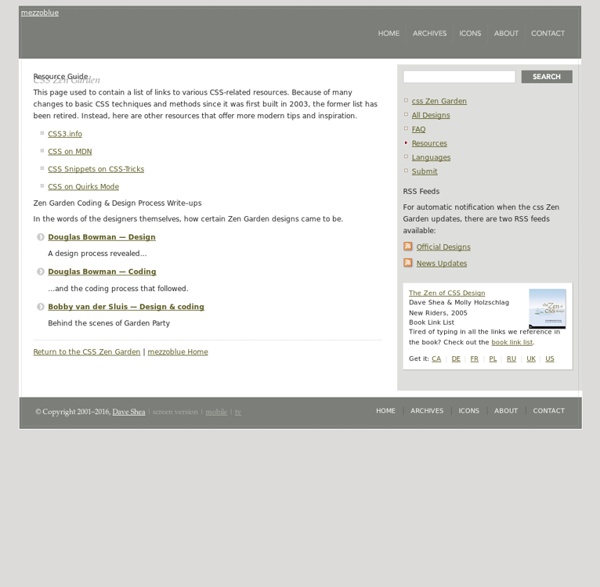Free WordPress Themes: 2011 Edition - Smashing Magazine
css Zen Garden: The Beauty in CSS Design
CSS Zen Garden: The Beauty in CSS Design
So What is This About? There is a continuing need to show the power of CSS . The Zen Garden aims to excite, inspire, and encourage participation. CSS allows complete and total control over the style of a hypertext document. Participation Strong visual design has always been our focus. You may modify the style sheet in any way you wish, but not the HTML . Download the sample HTML and CSS to work on a copy locally. Benefits Why participate? Requirements Where possible, we would like to see mostly CSS 1 & 2 usage. Luckily, designing this way shows how well various browsers have implemented CSS by now. We ask that you submit original artwork. This is a learning exercise as well as a demonstration. Bandwidth graciously donated by mediatemple .
Fudgegraphics
ISO/IEC 8859-1
ISO-8859-1 is the IANA preferred name for this standard when supplemented with the C0 and C1 control codes from ISO/IEC 6429. The following other aliases are registered for ISO-8859-1: iso-ir-100, csISOLatin1, latin1, l1, IBM819, CP819. Coverage[edit] Each character is encoded as a single eight-bit code value. Languages with complete coverage[edit] Languages commonly supported but with incomplete coverage[edit] Quotation marks[edit] For some languages listed above the correct typographical quotation marks are missing, as only « », " ", and ' ' are included. History[edit] ISO 8859-1 was based on the Multinational Character Set used by Digital Equipment Corporation in the popular VT220 terminal. In 1985 Commodore adopted ISO 8859-1 for its new AmigaOS operating system. In 1992, the IANA registered the character map ISO_8859-1:1987, more commonly known by its preferred MIME name of ISO-8859-1 (note the extra hyphen over ISO 8859-1), a superset of ISO 8859-1, for use on the Internet.
Creating an Executive Summary
Word includes a special tool that creates automatic summaries of your documents for you. This tool is called AutoSummarize, appropriately enough. The summary can be any length you specify, and you can save it to a new document, add it to the beginning of your document, or simply highlighted it in place. This feature allows you to quickly create a starting point for an executive summary. Notice that I said AutoSummarize creates a "starting point." This is because the summary is based on what Word can figure out about your document. To use the AutoSummarize feature, follow these steps: Load and display the document you want to summarize.Choose AutoSummarize from the Tools menu. Figure 1. In the Type of Summary area, specify which of the four summary types you want to create.In the Length of Summary area, indicate by using the Percent of Original drop-down list exactly how long you want the summary to be.Click on the OK button. Do More in Less Time! Comments for this tip: -Allen Thanks,-Ross
Design tools and resources, best of 2010
Another year ends and a new year begins, there have been 12 months full of news in the web design world, from the New Twitter design to the constant grow of HTML5 and CSS3, there has been tons of events that have changed the web panorama during this year. We spent all the year digging across the web to find those little secrets that were waiting for being discovered. We have reunited a huge collection of news and resources that saw the light during 2010, we did the work for you and now everything that you missed during this year that ends is here, ready for you to look into it. This roundup covers several aspects that will definitely help web designers and developers, including wireframing tools, widgets, color management apps, text editors and more; you will find along with the link a short review about each item of the list, let’s hope that this list will help you to remember all the good things that the last year of this decade has left for all of us. New GUI sets iPad GUI set Minus
UTF-8
The official IANA code for the UTF-8 character encoding is UTF-8.[6] History[edit] By early 1992 the search was on for a good byte-stream encoding of multi-byte character sets. The draft ISO 10646 standard contained a non-required annex called UTF-1 that provided a byte-stream encoding of its 32-bit code points. In July 1992, the X/Open committee XoJIG was looking for a better encoding. In August 1992, this proposal was circulated by an IBM X/Open representative to interested parties. UTF-8 was first officially presented at the USENIX conference in San Diego, from January 25 to 29, 1993. Google reported that in 2008 UTF-8 (misleadingly labelled "Unicode") became the most common encoding for HTML files.[9][10] Description[edit] The design of UTF-8 can be seen in this table of the scheme as originally proposed by Dave Prosser and subsequently modified by Ken Thompson (the x characters are replaced by the bits of the code point): The salient features of this scheme are as follows: Examples[edit]



